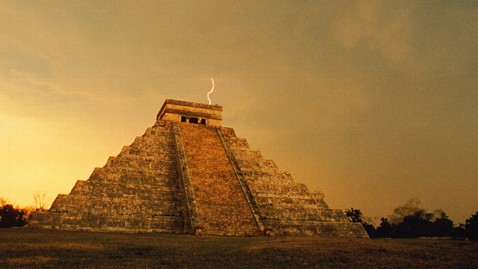2012 End-of-the-World Countdown Based on Mayan Calendar Starts Today

Stone/Getty Images
The countdown to the apocalypse is on.
We're one year away from Dec. 21, 2012, the date that the ancient Mayan Long Count calendar allegedly marked as the end of an era that would reset the date to zero and signal the end of humanity.
But will it?
There have been many end of times predictions over the years. Christian radio host Harold Camping faced widespread ridicule when his predictions that the world would end twice this year - on May 21, and then on Oct. 21 - failed to materialize.
But in the flurry of doomsday predictions - there have been similar dire warnings about the world coming to an end from various cultures, including Native Americans, the Chinese, Egyptians and even the Irish - the supposed Mayan prophecy seems to have held the most sway with believers.
The Mayan civilization, which reached its height from 300 A.D. to 900 A.D., had a talent for astronomy. Advanced mathematics and primitive astronomy flourished, creating what many have called the most accurate calendar in the world.
The Mayans predicted a final event that included a solar shift, a Venus transit and violent earthquakes.
Their Long Count calendar begins in 3,114 B.C., marking time in roughly 394-year periods known as Baktuns. Thirteen was a significant, sacred number for the Mayas, and they wrote that the 13th Baktun ends on Dec. 21, 2012.
The doomsday theories stem from a stone tablet discovered in the 1960s at the archaeological site of Tortuguero in the Gulf of Mexico state of Tabasco that describes the return of a Mayan god at the end of a 13th period.
"The Maya are viewed by many westerners as exotic folks that were supposed to have had some special, secret knowledge," said Mayan scholar Sven Gronemeyer. "What happens is that our expectations and fears get projected on the Maya calendar."
Gronemeyer, of La Trobe University in Australia, compares the supposed Mayan prophecies to the "Y2K" hype, when people feared all computer systems would crash when the new millennium began on Jan. 1, 2000.
For some reason, Gronemeyer says, people have ignored evidence that dates beyond 2012 were recorded.
The blogosphere exploded with more speculation when Mexico's archaeology institute acknowledged on Nov. 24 a second reference to Dec. 21, 2012, on a brick found at other ruins.
"Human beings seem to be attracted by apocalyptic ideas and always assume the worst," Gronemeyer said.
Believers have taken the end-of-the world fears to the Internet with hundreds of thousands of websites and blogs. Yet others are capitalizing on the heightened interest. Films depicting the end of the world - including the 2009 movie, "2012? - are contributing to the mounting hype as well as to misinformation, experts say.
In southern Mexico, the heart of Maya territory, a yearlong celebration is planned.
Mexico's tourism agency expects to draw 52 million visitors by next year only to the regions of Chiapas, Yucatan, Quintana Roo, Tabasco and Campeche. All of Mexico usually lures about 22 million foreigners in a year.
It's selling the date, the Winter Solstice in the coming year, as a time of renewal. Many archeologists argue that the 2012 reference on a 1,300-year-old stone tablet only marks the end of a cycle in the Mayan calendar.
"The world will not end. It is an era," said Yeanet Zaldo, a tourism spokeswoman for the Caribbean state of Quintana Roo, home to Cancun. "For us, it is a message of hope."
For those who are thinking about how to spend what could be their last year on earth, here's another message of hope: According to recent research, the mythological date of the "end of days" may be off by 50 to 100 years.
To convert the ancient Mayan calendar to the Gregorian (or modern) calendar, scholars use a numerical value (called the GMT). But Gerardo Aldana, a professor at the University of California, Santa Barbara, has said the data supporting the widely-adopted conversion factor may be invalid.
Aldana isn't the only detractor.
The National Aeronautics and Space Administration - yes, that's NASA - has also weighed in on the issue.
The agency's scientists posted answers to the most popular questions about the end-of-times theory associated with the prophecy.
"Remember the Y2K scare? It came and went without much of a whimper because of adequate planning and analysis of the situation. Impressive movie special effects aside, Dec. 21, 2012, won't be the end of the world as we know," the 2009 web page post says.
The answers addressed questions about whether there were any known threats to the Earth and the truth about the calendar.
One of answers posted was to the question of the possible approach of Nibiru (or Planet X or Eris), a supposed wayward planet that is said could pose a threat to Earth. The answer was a definitive rejection of the idea.
"Nibiru and other stories about wayward planets are an Internet hoax," scientists wrote. "There is no factual basis for these claims. If Nibiru or Planet X were real and headed for an encounter with the Earth in 2012, astronomers would have been tracking it for at least the past decade, and it would be visible by now to the naked eye. Obviously, it does not exist. Eris is real, but it is a dwarf planet similar to Pluto that will remain in the outer solar system; the closest it can come to Earth is about 4 billion miles."
ABC News' Susan Donaldson James and The Associated Press contributed to this story.